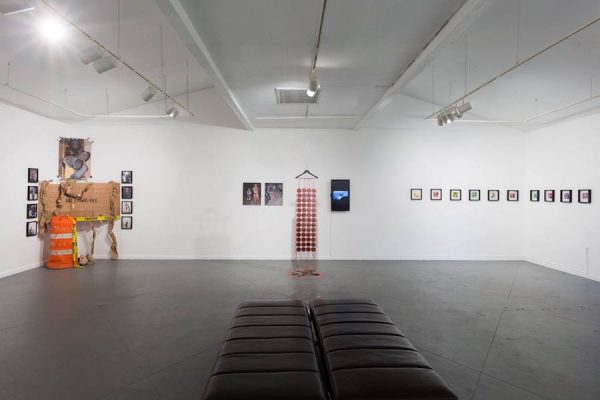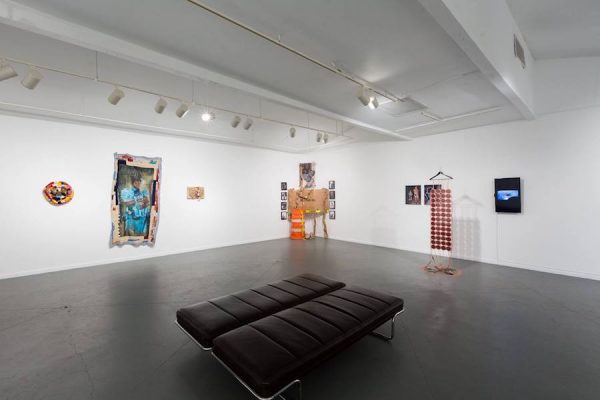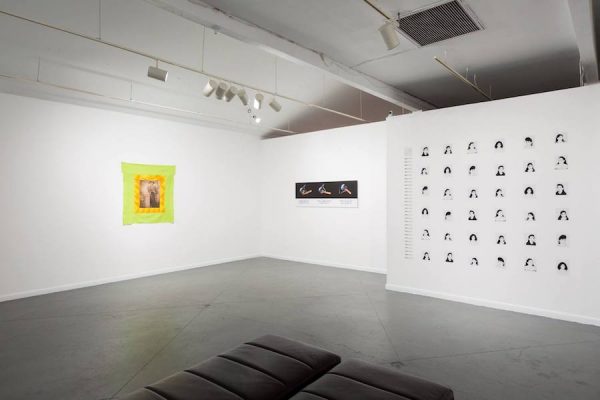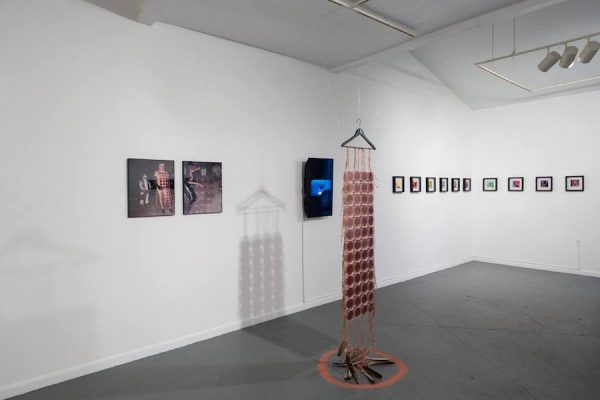This article is published concurrently with the Spring of Latino Art and the Latino Art Now! (LAN) national biennial conference and related programming taking place in Houston during the springtime of 2019.
I spoke with curator Reyes Ramirez and participating artist Moe Penders about Here, Ahora: Houston, Latinx, Queer Artists Under 30 — an exhibition currently on view at Art League Houston featuring work by Leticia Contreras, Jessica González, Romeo Harrell, Ángel Lartigue, Trevon Latin, and Isaac Reyes.
Lauren Moya Ford: Houston has the fifth-highest concentration of Latinx people of major American cities, but in a recent article in OutSmart Magazine, participating artist Isaac Reyes calls this exhibition a “takeover” — a hard-won chance to share his and other young, queer Latinx artists’ work. What’s it been like for these artists in the Houston art world before this show? What were the issues you wanted to address?
Reyes Ramirez: Houston institutions have been active practitioners of gatekeeping and exclusion, whether it be panels about immigration without any experts of color, readings without any writers of color, publications that have historically excluded artists/writers of color, or exhibitions without artists of color. This issue is proven in a recent NALAC report where figures as low as less than 1% of funding from the Houston Endowment, the Cullen Foundation, the Powell Foundation and the Albert & Margaret Alkek Foundation went to Latinx organizations. As a cis-gender, heterosexual man, I can’t say how much this issue disproportionately and negatively affects Latinx members of the LGBTQ community.
As the title suggests, the exhibition at Art League is proof that young Latinx artists not only exist and create in Houston, so do its members in the LGBTQ community. The many adjectives in the title prove that Houston boasts large, diverse communities of color. You could make exhibitions with any number of intersectional identities. Yet, absurdly, that is not the case. There is no excuse for institutions to continue excluding these communities, because they are here and now. Latino Art Now! created a wave, absolutely. But will it last?
LMF: Reyes, in that same article you say that beyond providing a platform for the featured artists’ work, you also “wanted to make sure that they were being paid for what they do.” Compensation is a huge part of art making, and a huge blind spot: many artists are grossly underpaid for their labor, or they aren’t paid at all. How do financial considerations impact young, queer Latinx artists?
Reyes: How are artists found for exhibitions in historically empowered institutions? Through shows, recommendations, and media exposure. But if marginalized communities are being excluded from funding by institutions, galleries, universities, and publications, how can they be found? The internet has created new ways to be seen. Though the medium is free, the emotional, physical, mental, and artistic labor is not. Also, many institutions with funding in Houston don’t seem to use these accessible, free platforms to recruit artists that rely upon digital exposure, so how far can that go?
LMF: Reyes, you are a native Houstonian and you come from a writing background. Can you tell us how the project came about, and how you selected the featured artists? Did your relationship to writing factor into the way that you curated this exhibition?
Reyes: Many of the greatest artists/writers working in Houston are people of color, but I never see proportional support from institutions of marginalized communities in the arts. Most of the artists in the exhibition are people I already knew and respected, artists who are doing amazing, beautiful work but are rarely compensated. As someone who dedicates their life to writing and has experience working with arts nonprofits, I know how difficult it is to even get a position on a non-profit staff or get a grant. Proposals, cover letters, and grant applications require an institutional language that often demand artists/writers of color to revisit traumas or accept that they cannot write in institutional language.
I felt that to fully serve marginalized communities, I have to use my privileges (in terms of writing, race, sexual orientation, and institutional experience) to, at the very least, secure funding for people that I respect. I love Houston too much to not say something about this absurdity. Also, as a writer, I found that the creative writing community in general closes itself off from the other arts. As such, I also wanted to pay writers to be in conversation with artists. That upcoming event can be found here.
LMF: Moe, you’ve recently curated El Chow: Mango Verde. Please tell us more about the project and featured artists, and how it complements or diverges from the Here, Ahora Art League Houston show.
Moe Penders: I curated El Chow: Fruto en vaina in the spring of 2018. It featured Latinx women and queer people. As queer people we tend to get clumped like that, so I didn’t want to do that again. So I changed El Chow to be only queer artists. This spring I curated the second iteration, El Chow: Mango verde, which is on view at Sabine Street Studios, March 30 through May 18. As queer people we tend to be overlooked and cis hetero people are given opportunities before we are allowed to. It is a constant conversation I have with my trans and non-binary peers. El Chow was created with the intention of creating space for my peers, for the people who don’t get the opportunities, and who don’t usually have support. We make it happen however we can.
The presented artists/artworks investigate the complex nature of the emerging Latinx identity through themes of mysticism, immortality, transnational relations, communal healing, representation, and visibility, among other topics. For some of the artists in particular, El Chow includes a study of gender and of belonging. These artists’ works operate beyond the confines of the readily accepted social, cultural and gender norms. I love the conversations the art is having with other pieces. There are always underlying themes that come up once the show is up. For instance, the conversation of the digital world and the internet amongst queer people, and how we can create space to find community there, find safe spaces for art work and to be allowed exist. You can see this in Junior Fernandez & S Rodriguez’s installation Travelling which “is an attempt to map the contemporary social landscape of cruising.” Farrah Fang creates digital collages that evoke emotion from people in her community. Angel Lartigue’s work was initially created to be presented on Instagram and Tumblr, but now their work lives outside of the internet as well. There are artists talking about migration, labor that is reserved for femmes, as well as labour within the US that is also reserved for immigrants, and how this plays into systemic oppression.
LMF: The University of Houston is rated as one of the most diverse in the country, and five of the seven participating artists have attended or are currently attending UH graduate or undergraduate programs. Has the university has played a roles in fostering these artists’ careers? What can UH and other Houston academic institutions do to better serve young, queer Latinx artists in the future?
Reyes: I’m a graduate of UH, and have an MFA from Texas State University. Though universities and academic programs foster artists, they do so problematically for artists/writers of color. UH has disproportionate levels of faculty of color. I can’t speak as to how the university plays a role in the featured artists’ careers. In fact, Romeo Harrell just started at HCC, and he’s an amazing artist. The institution doesn’t inherently make an artist’s career. Every artist/writer perfects their practice in their way; universities have to make the decision to support artists/writers of color or to continue to stand in the way. Though I wouldn’t take my academic career back, my university learning was fraught with institutional racism at both UH and Texas State.
Penders: Hire a more diverse staff. UH is one of the most diverse schools, but the faculty doesn’t reflect those who attend, and therefore it is difficult for students to see themselves in these institutions, or see the work of their people represented by these institutions. That is probably the most necessary thing. Hire more black and brown professors.
On view at Art League Houston through May 4, 2019.
Photos by Alex Barber.
La Tierra Tuya Es El Tema De Mis Canciones / Performances + Artist Discussion featuring Jessica González, Erick Zambrano, Veronica Gaona, Antonia Claros, Farrah Fang and Ángel Lartigue: 7 PM, Tuesday, April 30, 2019 (click here for more information).
Reading organized by Reyes Ramirez, along with Lupe Mendez and Jasminne Mendez of Tintero Projects, HERE, AHORA: Houston Conversations, Queer ART + LIT: 7:30 PM, Thursday, May 2, 2019 (click here for more information).
Lauren Moya Ford is an artist and writer based in Madrid.








